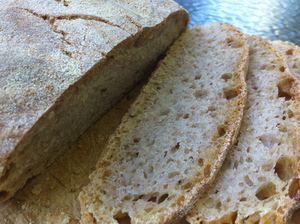How to get good crust on your bread: oven spring and steam

Forty-thousand bricks hold the heat in this industrial bread oven at Zingerman's Bakehouse.
Corinna Borden | Contributor
Oven spring is the name for the initial tumultuous activity - the bounce, the jump, the spring - yeast undergo when they are confronted with high heat. By adding steam, the outside of the loaf is softened sufficiently for the expanding yeast on the cooler inside to expand beyond what would be possible if the outside were a rigid shell.
Yeast dies at 140 degrees. Therefore, the yeast on the outside of the dough die from the heat of the oven before the yeast on the inside of the loaf. Once the yeast in the outer shell is dead the steam prevents the crust from burning as the interior of the loaf steams and cooks. The intense heat on the outside of the loaf caramelizes the proteins and the sugars in the wheat, sweetening the loaf and adding complexity and savory nuances of flavor. The outside of a crusty loaf should be dark, much darker than Wonder Bread, darker than you think you want - because a dark outside means more of those savory flavors have seeped into the internal crumb of the loaf.
Similar to the setup at Mill Pond Bread, the bread area at Zingermans Bakehouse revolves around the large brick ovens. Two smoldering behemoths sit placid and benevolent, spewing forth hundreds of light airy, crusty loaves a day (thousands during the holiday season). The bakers load the dough onto the 480-degree stones and then quickly push a button releasing water, “injecting steam,” onto the springing yeast of the loaves. After the first 20 minutes of baking, bakers open a vent, releasing the steam.
There are several suggestions professional bakers give home cooks to recreate the action of a professional steam-injected bakers oven. First you must preheat the oven beyond the bell. An oven is not hot when the bell goes off. The bell goes off only when the air inside is heated, not the walls, so the moment you open the door, whoof! - all of your heat escapes. One can add a pizza stone to your oven and pre-heat for 30-45 minutes to make sure the stone is thoroughly heated - the extra mass helps retain the heat.
To create steam, you can put a cast-iron pot on the bottom of your oven and splash in water when you put in your bread or even throw ice cubes onto the hot oven floor. There are various gadgets available online people have cobbled together to create a steam injected oven.
The difficulty is that steam does not stay in your home oven. Most ovens have vents that quickly dissipate the moisture you want to stay near the cooking loaf. There is no way to remove the steam when you want to, as professional bakers do when they open the oven vent - for home bakers the steam is already gone.

This loaf was cooked in a Dutch pot - "an oven within an oven." The crust is very satisfying.
Corinna Borden | Contributor
Jim Lahey states in his book, My Bread: The Revolutionary No-Work, No-Knead Method, that he has solved this problem in one brilliant coup, he calls it, “an oven within an oven - the pot.” By preheating a Dutch oven and cooking the bread inside of that, one gets both the intense heat needed for oven spring and steam. The moisture emitted from the wet dough stays within the pot as steam, until you take the lid off after 25 minutes of cooking.
Initial experimentations with his method are promising.
Corinna volunteers with the Westside Farmers Market and wrote a book about many things.

